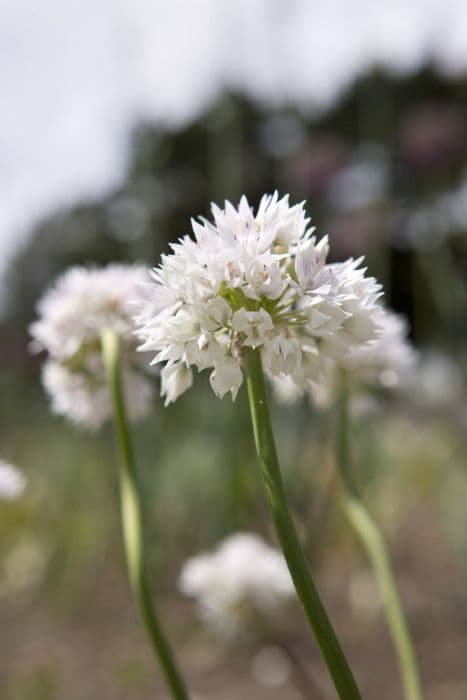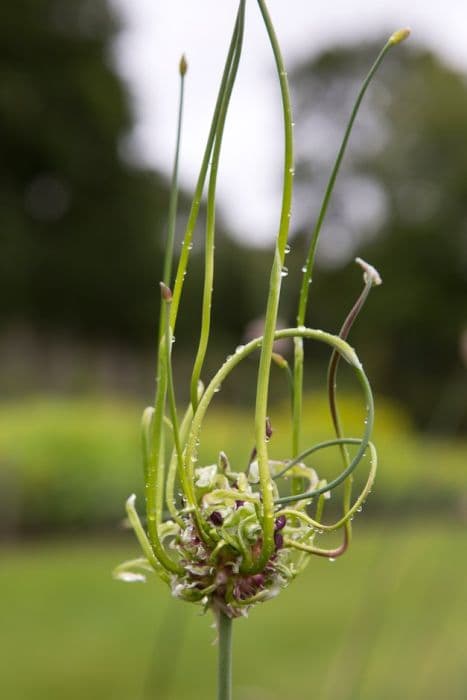Ornamental onion Allium 'Firmament'

ABOUT
Allium 'Firmament' is recognized for its striking spherical clusters of star-shaped flowers that come together to form a tight, globe-like head. These flowers boast a rich, violet-blue color that exudes a sense of depth and intensity, making a vivid statement in the garden. The floral globes are perched atop sturdy, upright stems that rise elegantly above the plant's strappy, green foliage. The leaves of the Allium 'Firmament' are typically elongated and narrow, contributing to an overall grassy appearance at the base, which serves as a contrasting backdrop to the ornamental flower heads. During its blooming season, this plant becomes a focal point in the landscape, drawing the eye with its unique and ornate flower spheres that are beloved by both gardeners and pollinators alike.
About this plant
 Names
NamesFamily
Amaryllidaceae
Synonyms
Ornamental Onion, Flowering Onion
Common names
Allium 'Firmament'.
 Toxicity
ToxicityTo humans
Allium 'Firmament', commonly referred to as ornamental onion, is generally not considered toxic to humans when used in ordinary culinary quantities. However, eating large amounts might cause discomfort, as it can with other members of the Allium family, such as onions and garlic. Ingestion in large amounts could potentially lead to symptoms such as gastrointestinal upset, nausea, vomiting, and diarrhea.
To pets
The ornamental onion, or Allium 'Firmament', is toxic to cats and dogs. If pets ingest this plant, they could suffer from symptoms which might include vomiting, diarrhea, abdominal pain, and in severe cases, a breakdown of red blood cells leading to anemia. If you suspect your pet has ingested this plant, it is important to consult a veterinarian as soon as possible.
 Characteristics
CharacteristicsLife cycle
Perennials
Foliage type
Deciduous
Color of leaves
Varies
Flower color
Blue
Height
2-3 feet (60-90 cm)
Spread
1-2 feet (30-60 cm)
Plant type
Bulb
Hardiness zones
4
Native area
Central Asia
Benefits
 General Benefits
General Benefits- Attracts Pollinators: Allium 'Firmament' can attract bees and other beneficial insects, supporting biodiversity.
- Drought Resistance: Once established, it is drought-tolerant, making it suitable for xeriscaping or low-water gardens.
- Deer and Rodent Resistant: The plant is typically resistant to deer and rodents, reducing the need for pest control.
- Easy to Grow: It requires minimal care and is known to be an easy plant to grow for gardeners of all skill levels.
- Ornamental Appeal: The striking spherical blooms add an architectural element to garden designs and landscapes.
- Long Blooming: It has a relatively long flowering period which helps to provide visual interest throughout the growing season.
- Culinary Uses: Some parts of the plant are edible and can be used in culinary dishes for flavoring.
- Soil Improvement: Like other alliums, it can help improve soil conditions and prevent soil compaction.
- Multiplication: It can naturalize and multiply over the years, providing more plants without additional cost.
- Seasonal Interest: With its unique blooms, it adds interest during the late spring to early summer garden lull.
 Medical Properties
Medical PropertiesThis plant is not used for medical purposes.
 Air-purifying Qualities
Air-purifying QualitiesThis plant is not specifically known for air purifying qualities.
 Other Uses
Other Uses- Allium 'Firmament', also known as ornamental onion, can be used in flower arrangements to add a unique spherical accent, as their round flower heads provide an interesting shape contrast.
- The sturdy stems of the ornamental onion can be dried and spray-painted to create colorful displays for craft projects or long-lasting bouquets.
- Allium 'Firmament' can be used in landscape design to repel deer and other herbivores that tend to avoid eating plants with strong odors.
- The dried seed heads of ornamental onions can be used as natural bird feeders, attracting seed-eating birds to the garden when left on the plant.
- Gardeners may use Allium 'Firmament' in combination with low-growing ground cover plants to create a height contrast and texture variation in flower beds.
- Ornamental onion bulbs can be planted in pots and forced to bloom early for indoor enjoyment during the late winter months.
- The allium's flower heads can serve as natural dye sources, with different parts of the plant producing varying shades for fabrics or artwork.
- Allium 'Firmament' can be integrated into a butterfly or pollinator garden as its flowers are attractive to bees, butterflies, and other pollinating insects.
- Used as a companion plant in the vegetable garden, the ornamental onion can help to deter common pests such as aphids or slugs from more susceptible crops.
- Allium 'Firmament' can be planted as a border or an edging plant to define paths and garden sections due to its upright growth habit and striking flower presence.
Interesting Facts
 Feng Shui
Feng ShuiThe plant name is not used in Feng Shui practice.
 Zodiac Sign Compitability
Zodiac Sign CompitabilityThe plant name is not used in astrology practice.
 Plant Symbolism
Plant Symbolism- Unity and Patience: The Allium 'Firmament', or ornamental onion, grows in clusters of flowers that symbolize close relationships and the patience required to maintain them.
- Strength and Resilience: As a hardy plant, it represents strength and the ability to overcome challenges.
- Prosperity and Abundance: The bulbous nature of the allium suggests wealth and the multiplication of resources.
- Protection: Historically, alliums were thought to ward off evil spirits and disease, representing safety and protection.
 Water
WaterOrnamental onions require moderate watering, especially during their active growth in the spring. Provide them with about an inch of water per week, either through rainfall or manual watering. It's crucial to avoid overwatering, as standing water can cause the bulbs to rot. During dry spells, water deeply once a week with about 0.5 gallons per square foot to ensure that the soil is moistened to a good depth. After flowering and as the leaves begin to die back, reduce watering to encourage the bulbs to go dormant.
 Light
LightOrnamental onions thrive in full sun conditions, which means they require at least 6 hours of direct sunlight a day. They perform best when planted in a location that receives unfiltered sunlight throughout the day, so a south-facing spot would be ideal for optimal growth. However, they can tolerate partial shade, especially in hot climates, but flowering may be less abundant.
 Temperature
TemperatureOrnamental onions are resilient to a range of temperatures but grow best in temperatures between 55°F and 75°F. They can withstand colder temperatures down to around 20°F and can survive short periods of frost, but may not tolerate extended periods of extreme cold. High temperatures above 90°F may also affect their growth, so it is optimal to plant them in a location where they can enjoy the cooler temperatures of spring and autumn.
 Pruning
PruningOrnamental onions need minimal pruning; the main goal is to remove spent flower stalks to prevent self-seeding and to maintain a tidy appearance. Prunal dead or yellowing foliage once it has died back naturally, usually in late summer or early fall. This also helps divert the plant's energy into the bulb for the next year's growth. Annual pruning after flowering, typically once per year, is sufficient for health and aesthetics.
 Cleaning
CleaningAs needed
 Soil
SoilOrnamental onions, like Allium 'Firmament', thrive in well-draining soil with a pH ranging from 6.0 to 7.5. A mixture containing equal parts of garden soil, compost, and sharp sand or perlite is ideal. The compost provides nutrients, while the sand or perlite ensures good drainage.
 Repotting
RepottingOrnamental onions, such as Allium 'Firmament', typically don't need frequent repotting and can be repotted every 3 to 4 years or when they outgrow their current container.
 Humidity & Misting
Humidity & MistingOrnamental onions, including Allium 'Firmament', are tolerant of a wide range of humidity levels and do not have specific humidity requirements.
 Suitable locations
Suitable locationsIndoor
Provide bright light, cool temperatures, and airy soil for indoor growth.
Outdoor
Ensure full sun, good drainage, and space out bulbs in a garden bed.
Hardiness zone
4-8 USDA
 Life cycle
Life cycleThe Allium 'Firmament', also known as ornamental onion, begins its life cycle as a bulb planted in the ground during the fall. In the spring, shoots emerge from the bulb as temperatures rise, with leaves developing to gather sunlight and nutrients. Following the vegetative stage, the plant enters the reproductive phase, producing a long stem topped with a distinctive spherical cluster of star-shaped flowers by late spring to early summer. After flowering, the plant sets seed; the flowers fade, seeds mature, and are dispersed by wind or wildlife. The above-ground foliage then withers and the plant enters a period of dormancy through the late summer and fall. Throughout winter, the plant remains dormant until the next growing season when the cycle restarts from the existing or new bulbs.
 Propogation
PropogationPropogation time
Spring-Early Summer
The Allium 'Firmament', commonly known as ornamental onion, is most often propagated by division. This process is typically done in the late summer to early fall, when the plant has finished flowering and is going dormant. To propagate by division, carefully dig up the clump of the plant, taking care not to damage the bulbs. Gently separate the bulbs into individual sections, ensuring that each division has at least one set of leaves or shoot and a portion of the bulb. These divisions can then be replanted immediately at the same depth they were previously growing. Water the newly planted bulbs thoroughly to help establish them in their new location. This method of propagation is straightforward and helps to rejuvenate overcrowded clumps, encouraging more vigorous growth and flowering in the following seasons.








